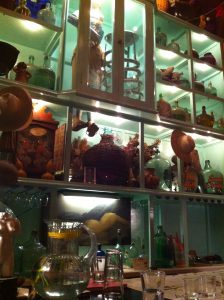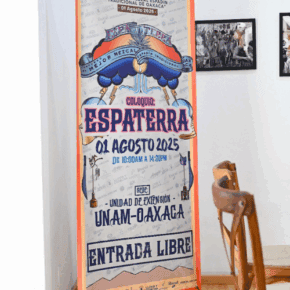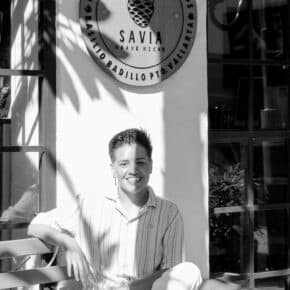
It was a hot night and we’d just returned the rental car. We planned on a little stroll, a little bite to eat – something relaxing. I stepped into Los Amantes while Alicia went to go grab a cup of coffee. I wanted to say hello to Leon Langle, the man behind the counter who knows his mezcal.
The space itself lends itself to easy conversation. It’s a small, cozily lit shoebox of a space that’s lined with antique glass jarras and benches. Of course the entire space is defined by the bar with a rotating selection of mezcal depending on what’s available. I never know what to expect: One night it will be empty so Leon and I can conduct an extensive discussion on his wares. The next evening it’s a colorful cacophony full of visitors from Mexico City and the odd celebrity sighting of Café Tacvba’s Ruben Albarran. This night it seemed like an impromptu meeting of palenqueros and brand owners.

There was Eric Hernandez, the palenquero behind Los Amantes and Ilegal, John Rexer, one of the owners of Ilegal, Francisco (mezcal and remembering last names can be a problem sometimes) from Wahaka Mezcal and Charles Collins from Real Matlatl. Eric had brought some pulque, a tart and refreshing drink that is less viscuous here in Oaxaca than the stuff I have tasted in Mexico City. I find it a nice accompaniment to mezcal – better than beer that can lead to a headache the following morning.
Leon poured me a madrecuixe/espadin mix, a pure madrecuixe and an arrenqueño. NB: The “tastes” at Los Amantes are actually quite generous and are more like shots. Several conversations flowed including how much better my Spanish gets after a few mezcals, traditional dishes from Sinaloa (there was a chef from Sinaloa there,) what artisanal means and what is going on with the wild magueys.
The artisanal question is pretty big and there was no consensus on defining it. Is it when mezcal is made by one palenquero using the traditional process? Or is it based solely on the process so that brands can claim to be artisanal when they use mezcal from different palenques? This is a question I ask all the time and it is fascinating that no one has the same answer. Unlike “organic” which is certified and therefore defined, artisanal is open to interpretation and, unfortunately, becoming highly misused (Round Table Pizza and their “artisanal” flat bread for example.)
As for the wild maguey question, it is a victim of its own demand at this point. Wild magueys often take 12 years to mature. Palenqueros like Enrique Jimenez (of Fidencio, Del Amigo and Mezcal Amores), Francisco of Wahaka, and many others control the land on which the wild magueys grow and are vested in harvesting only when they are ready. Other palenqueros who don’t have their own (either on their own land or communal property land – which is still very common in Oaxaca) or who don’t have agreements with communal property owners to harvest their own maguey, buy from harvesters who may be picking the magueys before they are ready. Given there is huge demand for the wild magueys, this is certainly an issue that needs to watched as there are huge ecological implications with the overharvesting that is happening. I love the wild maguey mezcals and the constant surprise of their flavor– one tobalá is different from another, the same with an arrenqueño, mexicano, tobaciche, etc. These are not every day mezcals.
Conversation then turned to music, which of course then lead to dancing. I wisely said my goodbyes and headed out to the brilliantly lit Santo Domingo before heading home.












Leave a Comment